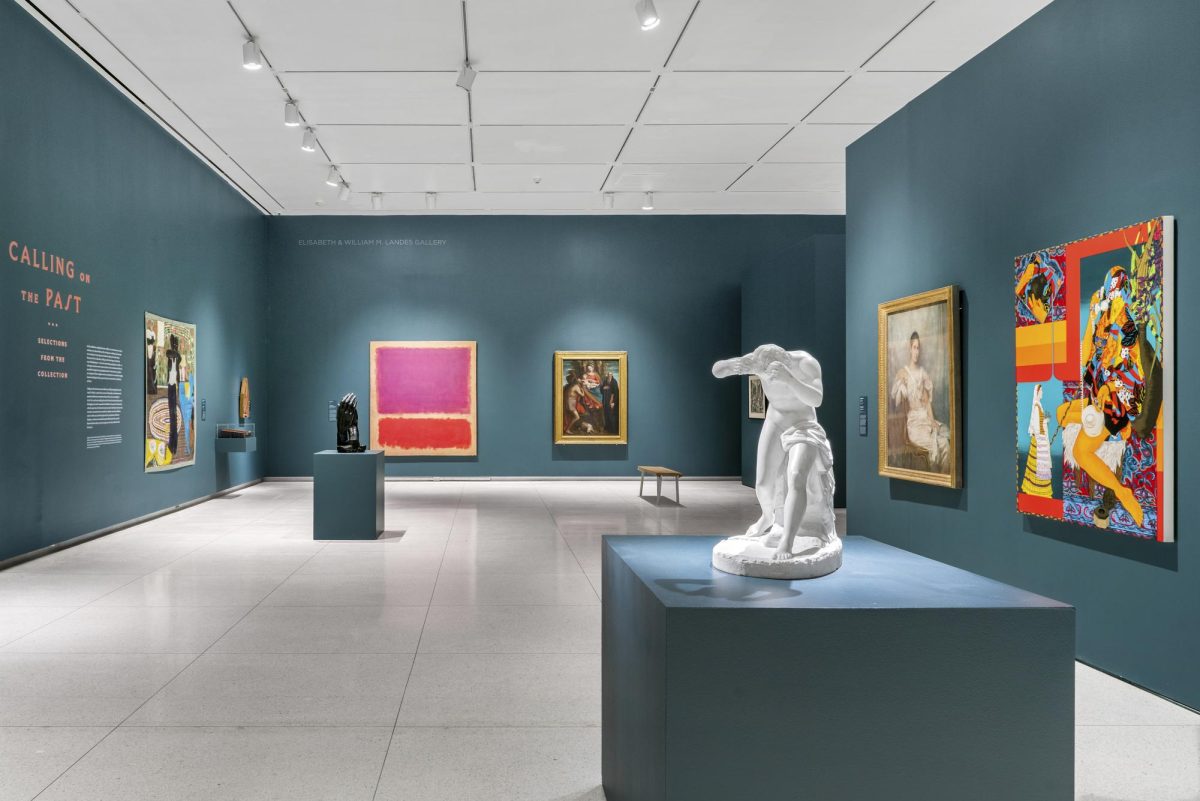The Smart Museum of Art has been holding the “Calling on the Past: Selections from the Collection” exhibition since March 23, 2023, aiming to “release artworks from prescribed narratives.” During my recent visit, I was intrigued by how the exhibition encourages viewers to appreciate objects across different historical periods simultaneously, defying traditional modes of organizing art based on chronological order, geographical origin, or artistic medium. Antiquities and contemporary paintings alike are stripped of their original contexts, thus encouraging the collision of multiple histories and sowing the seeds of new interpretations that speak across centuries and cultures.
The title of the exhibition, “Calling on the Past” is derived from a 2018 painting by Amir H. Fallah by the same name. When I first saw this painting at the exhibition, I did not recognize the piece as a typical portrait as it upends the standard conventions of portraiture: the face of the painted sitter is concealed. The modern piece captivates by steering away from intricate facial details and instead opting for vibrant and almost fluorescent colors and patterns that serve as cultural symbols. These aesthetic elements substitute for the face of the painted sitter to narrate an equally profound or perhaps even more nuanced story about the individual’s identity.
Positioned to the left of Fallah’s piece is Han Fechner’s 1896 portrait of Agnes Sampson, a work predating Fallah’s by over a century. This deliberate juxtaposition exemplifies a recurring theme within the exhibition—cross-chronological arrangement. Han Fechner’s portrait stands in stark contrast with Fallah’s swathes of bright colors and metaphorical representations. It displays a classical approach to portrait painting, with muted hues and distinct lines that depict the reality of a beautiful socialite in late 19th-century Germany. The two portraits, purposefully positioned next to each other, engage in a dialogue across centuries, exploring varying avenues of portraying identity.
My favorite part of the exhibition is undoubtedly the pairing of Kitagawa Utamaro’s Taking Shelter from a Sudden Summer Shower Under a Huge Tree and Ivy Haldeman’s Twice Colossus, Head Leans Left, Pinky Up, Head Leans Right (Gaze). The two canvases, given their conspicuous differences in style and content, quickly captured my attention, but they are just one of the many interesting combinations. Utamaro is one of the most renowned ukiyo-e artists of the Edo era, so her works (including this one) can be said to be quintessential, especially in the sensual depictions of women. To the left of Utamaro’s work is Haldeman’s painting. Completed in 2021, the painting depicts two anthropomorphic hotdogs lounging on pillows, which are, according to its description, “imitating gestures of girlfriends sharing secrets”. The personification of hotdogs, a blatantly modern spin, does not shroud the ukiyo-e influence on this modern painting, as seen in its graphic style. Despite their three-century gap and strikingly different objects of interest, the two works share a similar use of “bold and graphic lines” with Haldeman directly citing Utamaro as “a pivotal influence” on her practice.
The deliberate disruption of traditional display methods acts as a catalyst for reevaluating personal preconceptions and becomes an inquiry into the nature of artistic expression. By navigating the intersections of disparate time periods and artistic styles, the exhibit challenges the arbitrary delineations of historical epochs and threads the universal aspects of the human experience through the past and the present. In essence, the exhibition stands as a testament to the transcendence of art beyond temporal or geographical constraints. It kindles a dialogue beyond gallery walls to deny historical hierarchies and prompt an introspection of art, identity, perception, and narratives.









